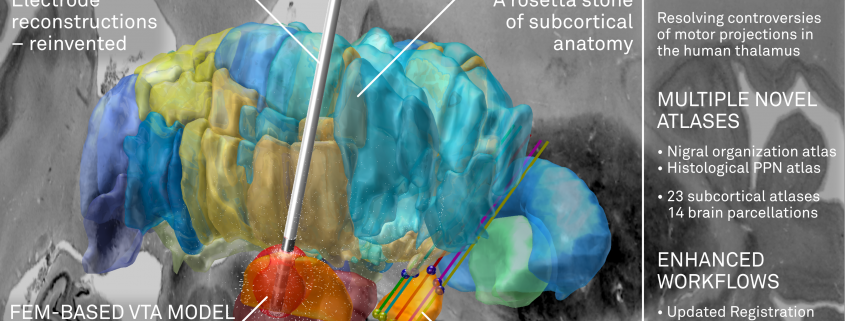Lead-DBS 2.0 out now
We are proud to release Lead-DBS 2.0 to the community – an open source tool to localize Deep Brain Stimulation (DBS) electrodes in the human brain.
A detailed description of all major new features is available here [http://www.lead-dbs.org/?p=3174], but in a nutshell they are:
- DISTAL atlas: A detailed brain atlas of the human subcortex based on histology (graciously provided by M. Mallar Chakravarty and Louis Collins), MRI and structural connectivity. It is available in three different nomenclatures, thus serving as a rosetta stone for thalamic nomenclatures (See Siobhan Ewert‘s
; for a summary see here [http://www.lead-dbs.org/?page_id=2911]).
- FEM-based VTA model (beta): To model the physical effects of DBS in the brain, we teamed up with Johannes Vorwerk (SimBio/FieldTrip toolboxes) and Qianqian Fang (Iso2Mesh toolbox). Further help was provided by Ningfei Li (integration inside Lead-DBS), Robert Oostenveld (Initial counseling and help with FieldTrip-related code). This is the first open-source pipeline to model volumes of tissue activated (VTA) as a one-step solution (see Connectivity Predicts deep brain stimulation outcome in Park…and this page [http://www.lead-dbs.org/?page_id=3291] for details).
- Human Motor Thalamus Atlas: Graciously provided by Igor & Kristy Ilinsky, the human motor thalamus settles controversies about motor projections in the human thalamus. It is based on specialized histological stains and was precisely co-registered to ICBM 2009b space. For more information about the dataset, see [http://www.humanmotorthalamus.com].
- PaCER: A fully automated method to precisely reconstruct DBS electrode localizations based on postoperative CT data will soon be published by Andreas Husch (Hertel group, Luxembourg) and was graciously provided to Lead-DBS. For more information about PaCER, see [https://adhusch.github.io/PaCER/].
- MER-Mapping: Ari Kappel (Richardson lab, Pittsburgh) and Chadwick Boulay (Sachs lab, Ottawa) created an intuitive and precise tool to combine DBS reconstructions with microelectrode recordings within Lead-DBS.
- Multiple novel atlases: In total, Lead-DBS now comes with 23 subcortical atlases [http://www.lead-dbs.org/?page_id=45] and 14 whole-brain parcellations [http://www.lead-dbs.org/?page_id=1004] suited for connectomics.
- Enhanced workflows: We re-designed large parts of the registration pipeline. For normalization strategies, all SPM routines, ANTs, FSL’s FNIRT and a MaGET-brain like procedure are available directly in Matlab (and without the need to install anything else).
We hope you like our new release – and please don’t hesitate to spread the word to colleagues in the DBS field. To download Lead-DBS now, see [http://www.lead-dbs.org].






Leave a Reply
Want to join the discussion?Feel free to contribute!